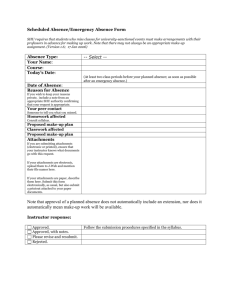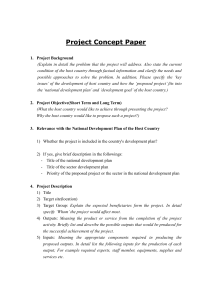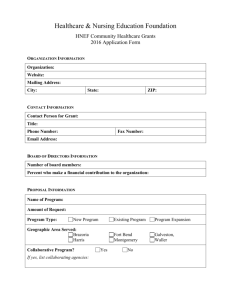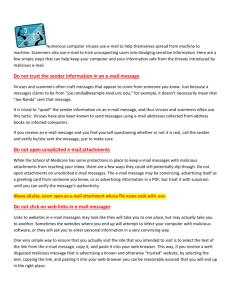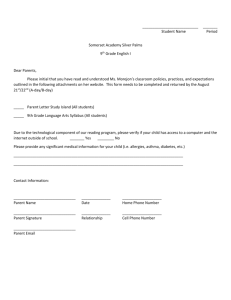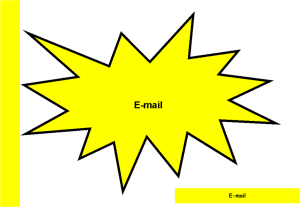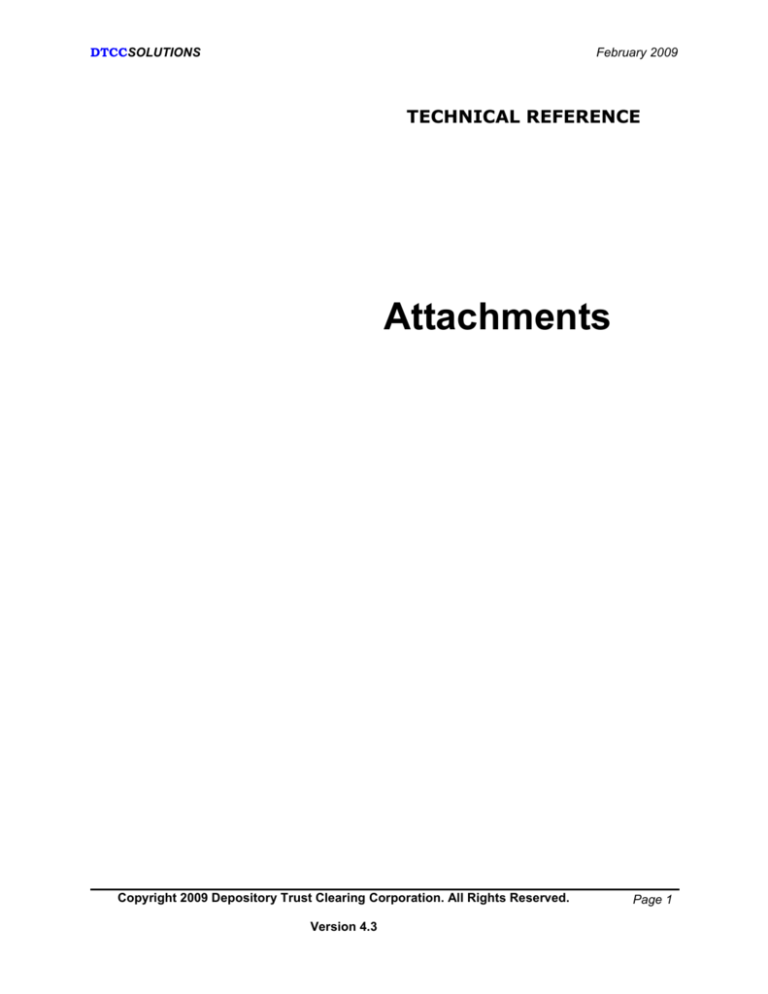
DTCCSOLUTIONS
February 2009
TECHNICAL REFERENCE
Attachments
Copyright 2009 Depository Trust Clearing Corporation. All Rights Reserved.
Version 4.3
Page 1
DTCCSOLUTIONS
February 2009
Table of Contents
1
Overview ................................................................................................................................................ 3
1.1
2
Attachments Features .......................................................................................................................... 3
Roles and Responsibilities .................................................................................................................. 4
2.1
2.2
2.3
3
Sender ................................................................................................................................................. 4
Recipient .............................................................................................................................................. 4
Attachments Server ............................................................................................................................. 4
Communication Protocols ................................................................................................................... 5
SOAP – Attachment Messages ........................................................................................................... 5
3.1
One-way SSL authentication...................................................................................................................... 6
4
Connectivity Implementation ............................................................................................................... 7
5
General ACORD XML Message Types ................................................................................................ 7
5.1
Supported Message Types .................................................................................................................. 7
6
SOAP Compliance ................................................................................................................................ 8
7
Software Services by Role ................................................................................................................... 8
7.1
7.2
8
Participants .......................................................................................................................................... 8
Insurance Attachments Server ............................................................................................................ 9
General Protocols for All Messages ................................................................................................... 9
8.1
8.2
8.3
8.4
8.5
8.6
8.7
8.7.1
8.7.2
8.7.3
8.8
8.8.1
8.8.2
XML Parsing Policy.............................................................................................................................. 9
Message Resend Policy ...................................................................................................................... 9
Message Logging Policy ...................................................................................................................... 9
Attachments ......................................................................................................................................... 9
XML Message Size .............................................................................................................................. 9
Attachments Virus Scan .................................................................................................................... 10
Web Service Requests ...................................................................................................................... 10
From Participant (sender) to Insurance Attachments Server: ........................................................ 10
From Insurance Attachments Server to Participant (receiver) Server: ........................................... 10
From Receiver Server to Insurance Attachments Server: .............................................................. 10
General Soap Envelope ..................................................................................................................... 10
Soap-header ................................................................................................................................... 11
SOAP-Body..................................................................................................................................... 11
9
TxLifeRequest for Attachments ........................................................................................................ 12
10
TXLifeResponse for Attachments ................................................................................................... 13
11
Appendix A: Schemas and Web Service Definition Language (WSDL) ...................................... 14
12
Appendix B: Router Exchange Form / IP Address / URL’s .......................................................... 14
13
Appendix C: Sample Messages ...................................................................................................... 17
Copyright 2009 Depository Trust Clearing Corporation. All Rights Reserved.
Version 4.3
Page 2
DTCCSOLUTIONS
February 2009
1 Overview
Attachments is a DTCC Web Service using XML technologies that sends documents between
distributors and insurance carriers. It is a standalone capability that can eliminate the need for a
paper exchange of information when signatures and/or original documentation are required for
otherwise automated processes.
There are unlimited assortments of items that may be handled as an attachment. The following
items are examples of possible attachments:
Forms
Images
There are 3 types of attachment processes:
The first type of message will support the movement of documents related to IPS fixed
format messages, such as APP and LNA. In this case, the attachment message would be
sent including key data for the receiver to be able to associate the attached document to
the original IPS data transaction (ex – document control number)
The second type of attachment message is a business message that does not have a
related IPS fixed format message. The same message structure as the first type would be
used.
The third type of attachment messages are unique business messages with imbedded
attachments, for example Replacements. The structure of these messages is based on the
underlying business message and will be defined in separate documentation.
Attachments messages are a combination of:
XML message definitions and DTCC business rules (XML schemas)
Protocol for using these XML schemas
Software service provided by various parties to use these schemas and protocols
Connectivity between various parties, allowing the software services to communicate
Definition of the roles, responsibilities, and security levels necessary to accomplish these
goals.
This document discusses Attachments technical specifications and message protocols.
1.1
Attachments Features
Creation of a standardized, automated process that will allow the exchange of digital
(imaged) documents, signatures, and forms during the pre-sale, new business and postissue processing of annuity and life insurance information.
Improvement of the overall user experience for participants by enabling Straight-ThroughProcessing
Increased levels of service to carriers and distributors
Copyright 2009 Depository Trust Clearing Corporation. All Rights Reserved.
Version 4.3
Page 3
DTCCSOLUTIONS
February 2009
Standardizes and centralizes processing by allowing firms to receive their documents in a
single format and allows firms a single solution for many of their carriers
Elimination of paper exchange which reduces the problems that arises when paper
documents are separated from the data message. By using an attachment message, the
receiver can automate the process
Decreases operating costs by reducing printing, faxing and overnight mail costs and
costs associated with the reconciliation process between data message and paperwork
Reduction of lead time by receiving documents at the same time as the data message
and premium dollars. It allows the annuity process by carriers to begin sooner.
Creation of an audit trail for all the steps completed within the document process in order
to meet compliance requirements
Utilization of established DTCC connectivity to ensure privacy and security
2 Roles and Responsibilities
There are several roles played by the various parties using the Attachments Server, and each
party may play more than one role as necessary to complete the business transaction.
The roles are:
2.1
Sender
The party initiating a real-time web service request for the Attachments Server. The Sender is
responsible for sending requests using the standardized XML message format.
Example, for New Business Applications, the Distributor would most likely be the Sender.
2.2
Recipient
The party that is responsible for responding to the Sender’s web service requests.
Example, for New Business Applications, the Insurance Carrier would most likely be the Recipient.
2.3
Attachments Server
The Attachments Server is a web service provided by DTCC which routes the XML-based
interactive inquiry messages from sender to recipient. The Attachments Server acts as a message
Transfer hub. Both parties can establish a single secure connection to the Attachments Server and
the ‘hub’ can handle requests and responses from all participating counterparties.
In addition to providing the Attachments service, DTCC's role is to standardize communication
formats, protocols, and security mechanisms allowing firms to interact with each other in real time.
The Attachments Server provides for an open message standard architecture, allowing any number
of firms to register for this service.
Copyright 2009 Depository Trust Clearing Corporation. All Rights Reserved.
Version 4.3
Page 4
DTCCSOLUTIONS
February 2009
3 Communication Protocols
3.1 SOAP – Attachment Messages
For Sender Participant:
Insurance Attachments supports the following communication protocol to communicate with sender
Participants.
• HTTPS: non-anonymous two way SSL using a digital certificate provided by DTCC, over the
SMART network.
When using a private network such as SMART, it is required that the IP address of each of the
Participant’s servers (or the virtual IP of a server farm) be registered. Specific firewall rules for
source and destination will be set up to allow access.
The Insurance Attachments Service can address the Participant using a DNS address.
The SOAP envelope message allows the Participant to specify the target Participant ID for the
message in the SOAP Header. Insurance Attachments will attempt to send the Web Service request
to the appropriate user environment based on the information provided in the SOAP Header.
B2B Authentication
The Participant has to set User-Agent in the request header. The string is sent by the Participant in
an http request header which will be used to indicate whether the request contains a password
Password is sent in by Sender. It is not in the response. The password will be provide to you by the
DTCC Registration Support Group during the digital certificate download process.
In order to authenticate, users must include their user password in the User-Agent http header.
The password value must be enclosed within specific delimiters, therefore, the format should be:
$DSD$password$DSD$
Below is the sample code and document explaining password in header.
HttpURLConnection connection=(HttpURLConnection)new URL(url).openConnection();
connection.setRequestProperty("User-Agent","$DSD$"+password+"$DSD$");
For Recipient Participant
Attachments support the following communication protocol when DTCC sends SOAP Request
message to the receiver’s server and when the receiver returns a SOAP response to DTCC.
• HTTPS: One way SSL using trusted CA, over the SMART network.
Copyright 2009 Depository Trust Clearing Corporation. All Rights Reserved.
Version 4.3
Page 5
DTCCSOLUTIONS
February 2009
One-way SSL authentication
One-way SSL authentication enables the application operating as the SSL client to verify the identity of
the application operating as the SSL server.
The SSL-client application is not verified by the SSL-server application. Figure 1 illustrates the certificate
configuration for one-way SSL authentication between two applications:
Figure 1. One-way SSL authentication, where DTCC is Client, Receiving Firm is Server
For more info on this see "General procedure for one-way SSL using CA certificates" under "Oneway SSL authentication"
http://publib.boulder.ibm.com/infocenter/tivihelp/v5r1/index.jsp?topic=/com.ibm.itim.infocenter.doc/cp
t/cpt_ic_security_ssl_authent1way.html
Receivers must present a trusted root CA back to DTCC to complete the handshake on the
outbound connectivity. The presentation of a intermediate or self signed certificate will not be
accepted.
DTCC recommends to use a standard certificate, not extended validation.
A list of Trusted Root CA’s that DTCC accepts can be found on Internet Explorer:
Internet Options -> Content -> Certificates -> Trusted Root CA
Or
In case of FireFox:
FireFox -> Options -> Advanced -> Encryption -> View Certificates -> Authorities
Copyright 2009 Depository Trust Clearing Corporation. All Rights Reserved.
Version 4.3
Page 6
DTCCSOLUTIONS
February 2009
4 Connectivity Implementation
To begin the Communication process, the following steps will occur:
Submit a Product Update Form (found on the Insurance Services website) identifying your
firm’s interest to participate in the Attachments process.
http://www.dtcc.com/products/insurance/members/forms/member_update_request-test.php
DTCC Implementation team will email your firm a ‘Router Exchange Form (REF)” for you to
complete. Note: Include your firm’s IP Address. (See Appendix B for a sample of the REF)
Email the completed Form to the DTCC Implementation team
DTCC will email a ticket number to you.
DTCC Network Engineering & Operations (NEO) will call the contact on the REF, to begin
the connectivity setup, which include router configuration, firewall setups, etc.
Once configurations are made, DTCC NEO will conduct a connectivity test with you to
ensure successful connectivity. This test only ensures that connection takes place prior to
reach the attachments application.
DTCC Registration Support Group (RSG) will email you to inform your firm of its User-Id,
Password and GeoTrust Digital Certificate information for you to download.
5 General ACORD XML Message Types
5.1
Supported Message Types
Message Type
Description
Attachments Message Request
Participant sends the message with attachments
Insurance Attachments service validates the XML
and send the message received to recipient
Participant
Insurance Attachments service sends response to
sender Participant after validating XML
Insurance Attachments service sends status to
sender Participant after receiving status from
receiver Participant
Insurance Attachments service sends response
failure to sender Participant if XML validation fails.
Insurance Attachments service sends failure
response receiver Participant if validation fails
Attachments Message Response
Attachments Message Response Failure
Copyright 2009 Depository Trust Clearing Corporation. All Rights Reserved.
Version 4.3
Page 7
DTCCSOLUTIONS
February 2009
Insurance Attachments messages are transmitted through the SOAP messaging protocol and using
DTCC Insurance Attachments schema based on ACORD XML standard format.
6 SOAP Compliance
DTCC developed the Attachments Web Services application using SOAP 1.1 technology with the
Document Literal mode of messaging in compliance with and according to the WS-I Basic Profile.
7 Software Services by Role
There are software services that must be offered in order to play the Participant role. In general,
software services are concerned with:
• Creating or handling an XML message appropriate for that role, or
• performing that role’s part of the protocol for the message.
Each message type uses its own protocol. Often the usage protocol for a message is self-evident
from the nature of the schema for that message type, or is strictly enforced by way of the schema.
This chapter documents the overall usage patterns expected by the Insurance Attachments Server.
Subsequent chapters document the remaining details of the usage protocol.
7.1
Participants
The Participants must provide a software service that connects to the Insurance Attachments Server.
The sender acts as a Web Service client (HTTPS) to the Insurance Attachments Server, and
Insurance Attachments Server acts as a Web Service End point (HTTPS) server to the sender. The
sender’s software service can make one or more HTTPS Web Service calls to DTCC Attachments
Service System; each message sent requires SOAP with attachment using MTOM. The
response message from the Receiver will be sent non-MTOM without attachment.
MTOM is the W3C Message Transmission Optimization Mechanism, a method of efficiently sending binary data to
and from web services. It uses XOP (XML-binary Optimized Packaging) to transmit binary data and is intended to
replace both MIME and DIME (DIME is a lightweight, binary message format that can be used to encapsulate one
or more application-defined payloads of arbitrary type and size into a single message construct) attachments. At the
very beginning of web services people thought of sending text data with SOAP messages. But after some time
people thought of sending binary files as a SOAP request or sending a sound clip as a web service request. So as a
solution to these problems MTOM came into the act.
http://publib.boulder.ibm.com/infocenter/wasinfo/v6r1/index.jsp?topic=/com.ibm.websphere.wsfep.multiplatform.doc/in
fo/ae/ae/cwbs_soapmtom.html
For more information, see JAX-WS 2.0 supports MTOM for SOAP 1.1
Using the HTTPS protocol, the sender makes a Web Service request to the Insurance Attachments
Server and waits until Insurance Attachments makes the HTTPS Web Service response. It is possible
that the Insurance Attachments server(s) cannot respond; the sender’s software service must
therefore be able to handle various Web Service Faults (timeouts).
Copyright 2009 Depository Trust Clearing Corporation. All Rights Reserved.
Version 4.3
Page 8
DTCCSOLUTIONS
February 2009
The receiver must provide a software service that receives Web Service requests from Insurance
Attachments Server. The receiver acts as a Web Service endpoint server (using HTTPS) to the
Insurance Attachments Server, and Insurance Attachments Server acts as a Web Service (HTTPS)
client to the Receiver. The Reciever’s software service must support more than one concurrent Web
Service request (HTTPS) from the Insurance Attachments Server.
Using the Web Services (HTTPS protocol), the Insurance Attachments Server makes a request to
the Receiver’s server and waits until the Receiver’s server makes the Web Service response
(HTTPS). Since the Receiver’s server(s) may be unable to respond, the Insurance Attachments
Server must therefore be able to handle various Web Service Faults. DTCC will timeout the
message if not responded.
7.2
Insurance Attachments Server
The Insurance Attachments Server must provide a software service that both receives from the
receiver’s software service and makes connections to the sender’s software service. The details of
these connections are described in the preceding sections.
8 General Protocols for All Messages
8.1
XML Parsing Policy
XML Schemas based on ACORD XML have been established for all message types. The
Participants can choose to perform XML Schema validation according to their business needs.
Insurance Attachments Server performs DTCC XML Schema validation for all messages it receives
without regard to origin from a sender or receiver. Insurance Attachments acts as a pass-through
for Participants messages. DTCC stores only statistical data about the message.
8.2
Message Resend Policy
The Insurance Attachments Server will automatically re-send requests on behalf of the sender up
to 3 times. If a request does not successfully reach the revivers system, the Insurance
Attachments Server will respond to the sender with a connection failure response message.
Receipt of a connection failure response message from the Insurance Attachments Server
successfully terminates the Insurance Attachments protocol. The sender controls any resends by
sending a separate request to the Insurance Attachments Server.
8.3
Message Logging Policy
DTCC always logs statistical information from the Insurance Attachments Message. The
Attachments Server implements a configurable logging policy for other message types and can log
depending on the message type, message origin, and message destination.
8.4
Attachments
DTCC expects attachments data MTOM. Inline attachments will not be allowed.
8.5
XML Message Size
It is in everyone’s interest to keep the size of the XML messages only as large as needed to
support the business functionality. A large XML file will cause resource constraints for all parties—
the distributors, Insurance Attachments Server and the insurance carriers. The sender can control
the size of the messages.
Copyright 2009 Depository Trust Clearing Corporation. All Rights Reserved.
Version 4.3
Page 9
DTCCSOLUTIONS
8.6
February 2009
Attachments Virus Scan
DTCC will not be scanning for viruses. DTCC will not be opening the attachments. Standard
procedures should have the receiver of the attachment scanning for viruses. If a virus is detected,
the recipient can send an error code indicating virus detected.
8.7
8.7.1
Web Service Requests
From Participant (sender) to Insurance Attachments Server:
• All requests from the distributor to the Insurance Attachments Server are sent using Web
Service requests.
• The sender can send the XML message as followings:
• Insurance Attachments Server supports XML type (xsd:anytype) to retrieve the
message from the request.
• Insurance Attachments Server responds to the Web Service request received. Refer the
WSDL section in the document.
8.7.2
From Insurance Attachments Server to Participant (receiver) Server:
8.7.3
All requests from the Insurance Attachments Server to a receiver are sent using Web Service
requests.
The Insurance Attachments Server sends the XML message to the receiver using XML type
(xsd:anytype). Refer the WSDL section in the document.
DTCC is going to send an Insurance Attachments request using one-way SSL.
From Receiver Server to Insurance Attachments Server:
All responses back to DTCC Server should be a SOAP Response, not a MTOM response. If
DTCC Server receives an MTOM response message, the message will be ignored and no further action
will be executed. This is to efficiently use the DTCC Server resources by processing only SOAP
responses.
Provided that response passes DTCC edit, DTCC will send reponse back to Sender. If response
does not pass DTCC edit validations, DTCC will send resendRequest (reject file) back to Receiver. No
action with DTCC is expected by Receiver from this request. The transaction is considered over after this
action occurs.
8.8
General Soap Envelope
The SOAP <Envelope> is a simple schema composed of a single <Header> tag and the <Body>
tag. The <Header> tag gives information about where to route the message, who has touched the
message, and what type of message in enclosed in the envelope. The <Body> tag encapsulates
any of the business messages.
The <Header> comprises routing information, which encapsulates a single < MessageHeader>
and contains <MessageName>, <AuthInfo> and <RouteInfo> tags. These tags give the Insurance
Attachments Server information about routing and all parties routing problem determination
information.
Copyright 2009 Depository Trust Clearing Corporation. All Rights Reserved.
Version 4.3
Page 10
DTCCSOLUTIONS
February 2009
If your application looks for SOAP Method Names (such as in .net), please note the following:
SOAP Method Names:
Stage2 Service Method Name: AttachmentService
Stage2 Error Method Name: ErrorService
Stage3 Service Method Name: AttachmentStatus
8.8.1
Soap-header
Element Description
Element
<MessageHeader>
<MessageName>
<AuthInfo>
<RouteInfo>
<FromParticipant>
<ToParticipant>
<Sender>
<RoutingTime>
8.8.2
Description
Root tag for the SOAP header
elements.
This is to give description about the
SOAP message. This is an optional
field.
This tag represents authentication
information and contains User Name
and Password information.
This tag contains Routing information of
the SOAP Request.
Sender participant number if it is a
Attachments request. Receiver
participant number if it is a Attachments
response.
Receiver participant number if it is a
Attachments request. Sender
participant number if it is an
Attachments response.
This is an optional field gives the details
of the company/person who is sending
the request on behalf of Sender or
Receiver.
The message sending time from the
sender/receiver.
SOAP-Body
The Attachments Server validates the contained elements of the <Body> tag as described in this
and the preceding chapters. A SOAP-Body contains one TXlife message. The TXLife request
contains one or more TXLifeRequest/TXLifeResponse messages. Please refer to the following
sections for each protocol for each business requirement.
Copyright 2009 Depository Trust Clearing Corporation. All Rights Reserved.
Version 4.3
Page 11
DTCCSOLUTIONS
February 2009
9 TxLifeRequest for Attachments
Copyright 2009 Depository Trust Clearing Corporation. All Rights Reserved.
Version 4.3
Page 12
DTCCSOLUTIONS
February 2009
10 TXLifeResponse for Attachments
Copyright 2009 Depository Trust Clearing Corporation. All Rights Reserved.
Version 4.3
Page 13
DTCCSOLUTIONS
February 2009
11 Appendix A: Schemas and Web Service Definition
Language (WSDL)
Download the Attachments WSDLs and Schemas (ZIP Archive, .zip) from the IPS Website.
This is the link to Record Layouts section where the WSDL and Schema are located.
http://www.dtcc.com/products/insurance/members/record_layouts.php
12 Appendix B: Router Exchange Form / IP Address / URL’s
The Router Exchange Form is filled out by participants prior to starting connectivity. This form is
used to provide the proper ip address and ports needed for setup. It also provides the inbound
and outbound urls needed to connect.
Inbound URL and IP Addresses (Sender to DTCC):
Production URL: https://server.dtcc.net/iatb2b/IAT/services/AttachmentService
Test URL: https://server.dtcc.net/iatb2bpse/IAT/services/AttachmentService
IP Address (for both Production and Test): 207.45.47.43
Port: 443
Outbound URL and IP Addresses (DTCC to Receiver):
These are the IP addresses that a transmission from DTCC to the Receiver will be sent from:
Production: 207.45.47.38
Test: 207.45.47.39
Port: 443
URL for Outbound: Receiving firm must provide DTCC with the URL/endpoint that they wish the
messages be directed to. There will be one URL for test and one URL for production. URL’s must be
HTTPS.
Copyright 2009 Depository Trust Clearing Corporation. All Rights Reserved.
Version 4.3
Page 14
DTCCSOLUTIONS
February 2009
The Insurance Attachments Server URL will be supplied on the DTCC Router Exchange Form.
DTCC Host
APPL.
System
Client Host
IP Address
TCP
Port
Subnet
Mask
IP
Address
Subnet
Mask
Attachments
Sender (inbound):
DNS URLs
https://server.dtcc.net/iatb2b/IAT/services/
AttachmentService
PROD
207.45.47.43
https://server.dtcc.net/iatb2bpse/IAT/servi
ces/AttachmentService
443
PSE
(TEST)
Copyright 2009 Depository Trust Clearing Corporation. All Rights Reserved.
Version 4.3
Page 15
TCP
Port
DTCCSOLUTIONS
February 2009
Participants must provide a URL to DTCC so that DTCC can initiate outbound connections. Below is the
information in the router exchange form that Recipients will need to provide in order to receive messages.
DTCC Host
APPL.
Client Host
IP Address
TCP
Port
PROD
207.45.47.38
443
PSE
(TEST)
207.45.47.39
443
System
Subnet
Mask
IP Address
Subnet
Mask
Attachments
Recipient (outbound):
URL Information (Carrier must provide
URR – DTCC will initiate an outbound
connection to the URL provided)
PSE (Test) URL:
________________________________
Note: Production URL’s will be
provided to Implementation in a
separate request at the time you are
ready to go into production.
Copyright 2009 Depository Trust Clearing Corporation. All Rights Reserved.
Version 4.3
Page 16
TCP
Port
DTCCSOLUTIONS
February 2009
13 Appendix C: Sample Messages
Sample messages are available at the IPS Website:
http://www.dtcc.com/products/insurance/members/record_layouts.php
Or click on:
Attachments XML Samples (ZIP Archive, .zip)
Note: The generated XML message could contain different data. These examples provided on our
website are for illustration purposes. Please consult the schema for more information.
Copyright 2009 Depository Trust Clearing Corporation. All Rights Reserved.
Version 4.3
Page 17
DTCCSOLUTIONS
February 2009
Change Log
DATE
VERSION
CHANGE
v1.0 to 3.0 – no change log
8/7/08
V4.0
Section 5.0 – added version of SOAP being used. It is 1.1.
Added 7.6 – info on Virus detection
8/12/2008
V4.1
Updated RECEIVER WSDL
Deleted URL link on page #8 and replaced it with other links. Details
on page #8.
Updated Sample Attachments message examples
12/4/2008
V4.2
Update 3.1 – added additional info on one way SSL with Trusted Cert.
3/20/2009
V4.3
Added 7.7.3 – Receiver Response – not sending MTOM response
3.1 – Added section B2B Authentication
Added 8.7.3 - From Receiver Server to Insurance Attachments
Server
8.8 – Added SOAP Method Names – for application that look for
SOAP Method Names (such as in .net).
11 - Removed actual WSDL from guide and included link to retrieve
on IPS Website.
12 – Included ip and urls for inbound and outbound setups
13- - Added link to retrieve additional sample messages on IPS
Website
Copyright 2009 Depository Trust Clearing Corporation. All Rights Reserved.
Version 4.3
Page 18


